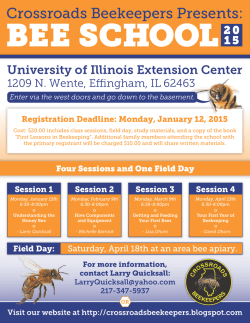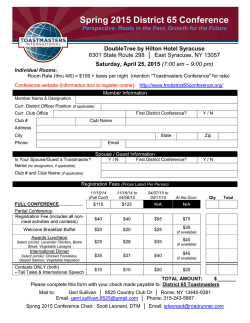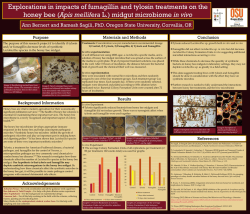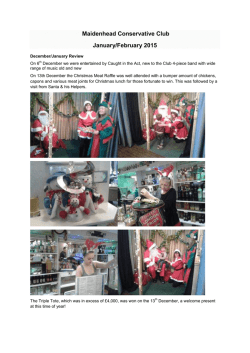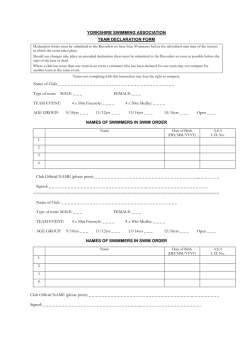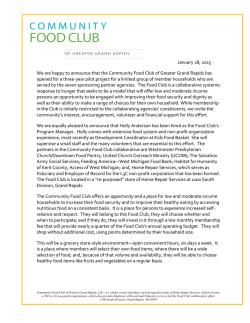
Download the latest Newsletter (Jan. 2015)
Volume 13, Issue 11 norfolkbees.org January 2014 President’s Message Shortly after I took over as President, a 7 year member of NCBA mentioned to me that blh he had observed that we were losing our more advanced beekeepers from the club. He noticed that people hung around for a few years after bee school and then faded away. It seemed that we were not doing enough in the way of education and programs to hold their interest. I saw his point. Shortly after that, I had a conversation with Dan Conlon – he said that it is a known phenomenon in bee clubs – 2 to 3 years of active participation, and then they start choosing which meetings they attend and soon are out of sight. I took this to heart, and set out to make NCBA more interesting to the more advanced beekeepers. We obviously need bee school, and beginners need a lot of instruction on the basics to ensure survival of their first colonies and keep them in beekeeping. I get that. But we also need to provide intermediate (and higher) level education for the more advanced members. We have some good programs lined up for regular meetings – Mary Duane, Dan Conlon, and Ed Karle will be speaking. We have an intermediate class with Erin Forbes – the class filled to capacity within 12 hours of being announced. So, if you are an intermediate to advanced beekeeper, especially one that has been slowly slipping away from NCBA, I’d like to hear from you about your wishes for educational programs, both for regular meetings and special programs on weeknights or weekends. Please suggest topics and/or speakers. Really, please let me know. We want you back! Email [email protected] Next Club Meeting February 2, 2015 400 Main Street Walpole, MA 7:30 Club Meetings: Board Members: President February 2, 2014 Mary Duane, EAS Master Bee Keeper Spring Preparation Ed Szymanski [email protected] Vice President Dave Shaner March 2, 2014 Don Conlon, Warm Colors Apiary Genetics – Russian Bees www.warmcolorsapiary.com [email protected] Treasurer Eileen Walther [email protected] Recording Secretary April 6, 2014 Ed Karle Photo Quiz Julie Norian May 4, 2014 Ed & Marian Szymanski – Planting for the Bees George Johnson – Mead Making June 2014 Club Picnic Editor Monthly Newsletter Board Meeting: The board of directors meets the 3rd Monday of each month (except July & August). Held 7:00 pm at the Woodside Montessori, 350 Village St. in Millis. All members are welcome and encouraged to attend. This is where decisions that guide how the club is run are made. Your input is invaluable. Events [email protected] Corresponding Secretary Dana Wilson Anne Kittredge [email protected] [email protected] Bee School Director Tony Lulek [email protected] Members at Large Judy Cox Bob Johnson Jessica Chen Committees: Extractor Debbie LaPlante [email protected] Librarian Eric Studer Door Prize/Raffle Kathy Varney IT/Web/Facebook Ed Szymanski Apparel Susan Robinson Historian The board of directors is looking for someone in helping to preserve the club’s history. If interested contact Ed Szymanski or any other board member. The Queen Stewardship Program committee met last week. There will be an equipment building "party" on 2/22 from 10 am to 4pm. It will be held at club member Henry Hahn's workshop at 56 R Elliott Street in Natick and there will be a pot luck lunch. Read at Your Own Risk Now that I have your attention I would like to ask a favor of you. The board would like to know what the readership level is of the monthly newsletter. So if you have read this far please click on or paste the following email address [email protected], in the send to line, and send an email to let us know that you do read this newsletter. If you feel ambitious you can also give the board some feedback. How frequently do you open the monthly newsletter? Do you have a favorite section? Is there anything you like to see added or more of? Any other suggestions that you might have? Thank you for taking the time and giving your feedback. Dana Wilson Corresponding Secretary Club Membership: "Go to www.norfolkbees.org to download renewal/enrollment form. Oooh, a blank spot! Any club members that would like to submit articles for publication Raffle Table could find their name here in lights! A reminder that that the club is in need of, and appreciates, all items brought to the raffle table. Bear in mind to keep the items of good quality and as bee related as possible. Membership dues offset less than half of the club’s yearly budget. This fund raising effort helps to close that gap. Besides there are some very nice items and we have fun! Do you have a blog about the bees? Farmer’s Markets Do you participate in Farmer’s Markets? Let us know where and what day and time of the week and we will publish where we can find you! Tell us all about it! Perhaps you are an artist? A photographer? Draw us a bee! Send your best photo! Words of wisdom! Honey Extractors The club has 6 extractors for club use. Contact Debbie LaPlante [email protected] if you would like to use one. Snack Table Snacks are provided for free at the monthly club meeting. Thanks to all of you who bring in sweets. Contact Julie Norian at [email protected] or Susan Packenham - [email protected] Susan would like it if you could bake something for November! Board Meeting Highlights The Queen Stewardship Program committee met last week. There will be an equipment building "party" on 2/22 from 10 am to 4pm. It will be held at club member Henry Hahn's workshop at 56 R Elliott Street in Natick and there will be a pot luck lunch. Bee School IS FULL! Club Membership Club membership runs form the calendar year. From January 1st through December 31st. Dues of $15.00 are collected at with the September’s club meeting for the up coming year or they can be mailed to: Eileen Walther 23 A Street Wrentham, MA 02093 The dues of $15.00 are for both the individual and family. If you attend Bee School the $50.00 fee include a year’s membership in the club. New Newsletter Sections Board meeting notes, news & new ideas! Please see the last pages of the Newsletter! Bee School may be full but there is a great article at the end of the newsletter that I totally enjoyed reading. I hope you enjoy it as much as I did! It is all about why bees choose certain type of space for their hives. Baked Honey Garlic Chicken Ingredients 1 pound boneless, skinless chicken breasts, cut into 1-inch chunks Kosher salt and freshly ground black pepper, to taste 2 large eggs, beaten 1 cup Panko* For the honey garlic sauce 1/3 cup honey, or more, to taste 4 cloves garlic, minced 2 tablespoons soy sauce 1 tablespoon Sriracha, optional 1 tablespoon cornstarch 2 green onions, thinly sliced 2 teaspoons sesame seeds (continued) Instructions Preheat oven to 400 degrees F. Lightly oil a 9x13 baking dish or coat with nonstick spray. Season chicken with salt and pepper, to taste. Working in batches, dip chicken into eggs, then dredge in Panko, pressing to coat. Add chicken to prepared baking dish. Place into oven and bake until golden brown and crisp, about 15-20 minutes. In a medium saucepan over medium high heat, combine honey, garlic, soy sauce and Sriracha, if using. In a small bowl, combine cornstarch and 1/3 cup water. Stir mixture into the saucepan until thickened, about 1-2 minutes. Stir in chicken and gently toss to combine. Serve immediately, garnished with green onions and sesame seeds, if desired. Looking for a FEW GOOD MEN AND WOMEN, and some KIDS TOO! The Norfolk County Mosquito Control visited our club last year upon an invitation from Scott Mofford. Over the past year I have been talking and meeting with Dave Lawson. They have put in a plan to test the effects of a pesticide called Duet on the honeybees. Three of their people will be attending bee school this year. They have also designated a place on town land in Medfield that they can use for testing. They will be purchasing 9 hives in total. They have asked me to approach the club to put a group together that will be their mentors. I will not be part of this group as I will be busy with the queen rearing, but this is also a great opportunity to really work on developing your own skills and management. They are especially interested in treatments used in the hives. They will be testing all components of the hives throughout the entire season. If you are interested, please contact me and we will put this group together. Thanks Tony Lulek Tony Lulek www.littlebeehivefarm.com h. 508-893-7970 c. 617-281-8867 Roasted Brussels Sprouts and Crispy Baked Tofu with Honey-Sesame Glaze Ingredients Brown rice Roasted Brussels sprouts 1½ pound Brussels sprouts 1½ tablespoons olive oil Fine grain sea salt Extra crispy baked tofu 1 (15 ounce) block of organic extra-firm tofu 1 tablespoon olive oil 1 tablespoon reduced-sodium tamari or soy sauce 1 tablespoon arrowroot starch or cornstarch Spicy honey-sesame glaze ¼ cup reduced-sodium tamari or soy sauce 3 tablespoons honey (maple syrup also works) 2 tablespoons rice vinegar 2 teaspoons toasted sesame oil 1 to 3 teaspoons chili garlic sauce or sriracha (depending on how spicy you like it) Garnish 2 tablespoons sesame seeds and fresh cilantro leaves, chopped Instructions Position your oven racks in the lower third and upper third of the oven. Preheat oven to 400 degrees Fahrenheit. Cook rice according to directions. Drain tofu and gently squeeze out some of the water. Slice the tofu in half lengthwise so you have two one-inch thick slabs. Press and drain well. Cut the sprouts in halves lengthwise. Toss the sprouts with olive oil. On a large baking sheet, arrange the sprouts in an even layer, flat sides down, and sprinkle with sea salt. Cut tofu into small pieces. Whisk together 1 tablespoon olive oil and tamari, then drizzle it over the tofu and toss to coat. Sprinkle 1 tablespoon arrowroot starch over the tofu, and toss the tofu until the starch is evenly incorporated. Arrange the tofu in an even layer on a baking sheet on parchment paper. To bake the sprouts and tofu: Transfer the pan of Brussels sprouts to the lower oven rack, and the pan of tofu to the top rack. Bake for 25 to 30 minutes, tossing the contents of each pan halfway through cooking, until the sprouts and tofu are deeply golden on the edges. To make the glaze: In a small saucepan, whisk together the glaze ingredients (start with 1 teaspoon chili garlic sauce or sriracha and add more to taste). Bring the glaze to a gentle boil over medium heat, stirring often and reducing heat as necessary, until the glaze is reduced by about half (about 10 minutes). Remove from heat. Pour the sesame seeds into a small dry pan. Toast for about 4 to 5 minutes over medium-low heat, shaking the pan frequently to prevent burning, until the seeds are turning golden and starting to make popping noises. Divide rice onto four plates. Top each plate with sprouts and tofu and drizzle with glaze. Finish each plate with a very generous sprinkling of sesame seeds and a small handful of chopped cilantro. NEW! Members in good standing may now insert a small classified ad in our newsletter for FREE! Please keep it simple and relevant to Bee Keeping, Bee Products, Home/Cottage Industries that you think would interest other members. Please email to [email protected] Woods Beekeeping Supplies Custom Hive stand and Screened Bottom Board Built as one piece instead of two separate pieces for stability. They are made with galvanized 1/8” screen and white plastic slide-in tray to count mites. Glued and screwed together for long lasting durability. Slatted Racks Completely assembled, glued and nailed. This gives the bees more room in the hive on rainy days and when they are all in for the night making them less likely to think about swarming due to crowding. Supers Made out of pine; with pre-drilled finger joints, and handles cut into boards, comes unassembled. Deep, Medium and Shallow available. Inner Cover Ventilated, wooden inner cover. Outer Cover covered with Tin Made from ¾ exterior plywood, completely assembled, glued and screwed. Cover comes with tin cover to protect from outdoor elements. Complete Hive Setup Includes screened bottom board, two deep supers, 20 frames with wax foundation, inner cover and outer cover. Hive Frames–Deep, Medium, and Shallow Wooden frame, made out of pine, held together with 10 nails. (Does not include wire or foundation). Browse or shop our online store www.woodsbees.com 401-305-2355 FULLY STOCKED RETAIL STORE POLLEN PATTIES WITH 15% REAL POLLEN SINGLE DOSE FUMAGILIN-B HONEY B HEALTHY HIVE TOOLS AND ACCESSORIES FEEDING SUPPLIES & FEEDERS PROTECTIVE CLOTHING HIVE COMPONENTS FOUNDATION WOODENWARE EXTRACTING EQUIPMENT JARS AND CONTAINERS BULK HONEY GIFT CERTIFICATES BOOKS A NEW BOOK! Published by our member Noah Wilson-Rich “I was just reading the latest NCBA newsletter, and noted an invitation for club members to submit a free classified ad. I recently wrote a book about bees, “The Bee: A Natural History” published through Princeton University Press. Perhaps we could include a note about this?” THE BEE A Natural History Noah Wilson-Rich With contributions from Kelly Allin, Norman Carreck & Andrea Quigley Hardcover | $27.95 | ISBN: 9780691161358 224 pp. | 8 x 9 Noah Wilson-Rich, Ph.D. Founder & Chief Scientific Officer The Best Bees Company 839 Albany Street (rear) Boston, MA 02119 [email protected] (office/lab) 617.445.2322 http://www.bestbees.com Twitter: @bestbees Facebook: www.facebook.com/bestbees location but such colonies seldom Extra, extra! survive the winter in temperate climates. Tropical bees survive with such nests Found an interesting article for newbees! more frequently. A darkened enclosure The Bee Nest (Basic Bee Biology for is needed for efficient wax secretion . Beekeepers) worker wax glands secrete more wax and bees build more comb in darker Apis mellifera is a cavity nester. sites compared to bees exposed to light. Understanding the basic nest ecology Honey bees search for suitable cavities has led to an effective and efficient, for their nest. Usually the searching is man-made hive . the Langstroth hive. done by scout bees from a swarm. The The natural or feral nest (and beekeeper European bees seldom move very far hive) has these five features: from the original homesite. From Sheltered, darkened enclosure Small, defensible entrance Size of adequate volume Hexagonal beeswax cells molded into parallel comb separated by bee space Separation of brood (a central sphere) and food (to the top and sides). A tree cavity is a common nest site in numerous studies their nest selection criteria involve: the temperate area. Maple, oak and ash trees are commonly available but bees will select virtually any tree if a suitable cavity is present. Knotholes are the most common types of opening but cracks or other openings can also be used. Bees prefer openings high in a tree, but will nest wherever the cavity is available. Most tree nests are in live trees; the cavities are the result of fungal action on the inner wood. Since beeswax comb is fragile, shelter is important for successful winter survival of a bee colony. Occasionally a bee colony will build in an exposed Volume . bees prefer 40 liters (range 20 to 100 liters). Tropical bees prefer smaller cavities and will nest in the open more readily. Height from ground . bees seem to prefer higher sites than those at ground level or close to the ground. Usually 3 meters (9 feet) is ideal. Exposure . sites in the open exposed to wind or full sun are less preferred. Entrance size & position . bees definitely prefer smaller entrance holes, openings at the bottom of the cavity and southward facing exposures. Cavity quality . bees prefer dry, unoccupied sites. They are attracted to smell of previous bee occupancy. extensive amounts of propolis, almost sealing the entrance area. Most nests have a single entrance. Worker bees manufacture the only necessary nest material - beeswax. The beeswax is molded into parallel beeswax sheets termed combs. Most of the comb consists of worker cells. The cells are six-sided (hexagonal) and have a three-part bottom pyramid shape. Cells are horizontal facing both directions from a central midrib that provides important comb strength. The cells slope slightly upward and are planed to minimum thickness with a rim of extra wax at the top of the cell walls for ease in walking. The hexagonal cells are of two sizes worker cells are used to rear worker A Typical Natural Bee Nest from: Seeley, T. D., Morse, R. A. (1976). The nest of the honey bee bees and for storage of honey and (Apis mellifera L.). Insectes Sociaux 23: 494- pollen. They average about five cells per 512. linear inch. Bees also construct some drone cells in their comb. Drone cells average about four per linear inch; they When scout bees search for a new homesite, they enter potential cavities and walk inside to measure dimensions. Because most cavities are in trees, the usual cavity is a tall cylinder. Once a homesite is selected, the swarm moves in. They may use propolis to smooth are larger than worker cells but are still six-sided and otherwise similar to worker cells. Drone cells are used to raise drones and can be used for honey storage. When in a feral nest, bees build mostly worker cells and only about 15% drone-size cells. the entrance and inner wall areas of In the natural nest, bees build several their nest and may reduce the size of parallel combs at one time. As the the entry area with propolis. Some bee colony expands, additional combs are races such as Caucasians use added. When building their comb, bees adhere to a basic principle in spacing; temperature requirements of the they leave approximately 1 cm or 3/8 of growing larvae. (Immature larvae need a an inch (the height of a bee) between temperature of 90-95° F or 32-36°C for combs. We call this space "bee space." optimal development.) Honey (stored as The comb is suspended from the top of food) is above and to the sides of this the nesting cavity. Spaces less than 3/8" central brood-rearing area. are filled with propolis. If the space is larger than 3/8", the bees will attempt to fill the space with comb. Pollen, needed to feed the larvae, is stored in empty cells in the brood area and immediately to the outside of the In the sheltered, darkened cavity, the active brood-rearing area. This central bees separate the area where they store sphere of brood expands or contracts their food and the area where they rear depending on the time of the season. their brood (brood = egg, larval and Cite: pupal stages of bees). The brood is reared in the lower portion of the beeswax comb in a compact, spherical- https://www.extension.org/pages/21753/thebee-nest-basic-bee-biology-forbeekeepers#.VM1BOGB0ycw shaped section because of the Bee Pied Piper?
© Copyright 2024
